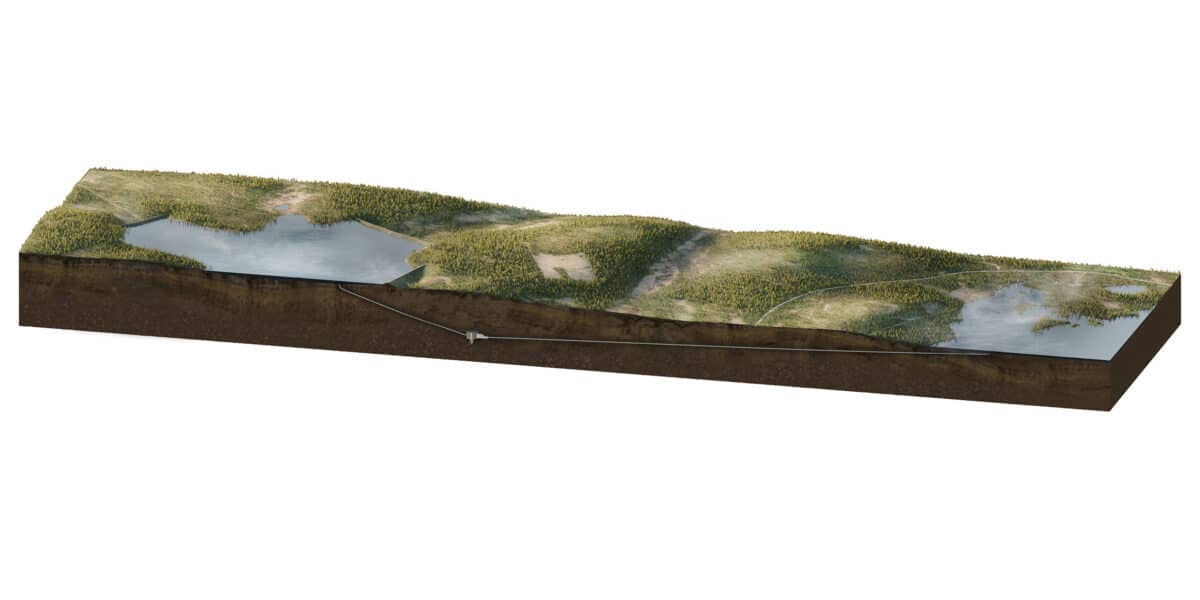The basic idea of a pumped storage power station is simple: when a lot of electricity is available – and the electricity is cheap – water is pumped to a reservoir higher upstream. When less electricity is available, and it is more expensive, the water is released from the upper reservoir and flows through a generator.
Pumped storage power plants consume more electricity than they produce. However, the plant’s reserves can quickly provide additional electricity when it is needed. It would also output electricity for much longer than a battery.
A pumped storage power plant can quickly use its reserves to generate additional electricity when needed.
For electricity production to be efficient, there must be a large enough elevation difference between the upper and lower reservoirs. In Central Europe, many pumped storage power plants have been built in mountainous areas.
A lot of renewable energy is currently being built in Finland, requiring a lot of balancing power alongside it. Pumped storage power plants have attracted interest as a potential solution in this area. Kemijoki, Pohjolan Voima and Suomen Voima, a joint venture involving 16 energy companies, have all publicised plans for pumped storage power plants.
The companies have their eyes on Lapland, especially Lake Kemijärvi, which would serve as the lower reservoir for the projects. The lake is large and is already regulated, so the expectation is that the environmental impact would be moderate. The necessary elevation differences also exist in the area.
Kemijoki aims for EU status
Kemijoki Oy aims to build a pumped storage power plant in Ailangantunturi, Kemijärvi. Petri Vihavainen, the company’s Vice President of Electricity Markets and Strategy, says the plant’s power would be 550 megawatts. It could output electricity at a lower power for a couple of days.
“The area of the pumped storage reservoir is about one square kilometre. The tunnel connecting it to Lake Kemijärvi is about 4.5 kilometres long, and the drop is about 200 metres.”
The ongoing environmental impact assessment (EIA) should be completed in early 2025. The pumped storage power plant is intended to be commissioned in the early 2030s.
“The scale of the project is large, and pumped storage power plants are a new thing for Finland, so we are studying the environmental impacts very carefully. At present, we estimated them to be minor because the lower reservoir, formed by Lake Kemijärvi, is so large.”
Vihavainen expects funding to be a challenge. The project’s budget is between EUR 600 million and EUR 800 million. It aims to secure EU status and European Commission funding.
Kemijoki Oy has other plans for pumped storage power plants in the area which it will announce later.
Pohjolan Voima also has a large project
Pohjolan Voima is planning a 500-megawatt pumped storage power plant in the Askanaapa area of Kemijärvi. Its budget also runs into the hundreds of millions of euros.
Jani Pulli, CEO of PVO-Vesivoima Oy, says that the project is in the feasibility study stage, after which it will progress to an environmental impact assessment. The aim is to commission the plant in the 2030s.
“The naturally bowl-shaped Lake Askanaapa would serve as the pumped storage power station’s upper reservoir. Its surface area would be about 300 hectares, its depth would be around 30 metres, and the drop to Lake Kemijärvi would average 150 metres. The power plant would be build into the rock.”
Pulli calculates that the plant could produce electricity below its maximum output for up to a week.
Suomen Voima aims for several small plants
Pekka Saijonmaa, CEO of Suomen Voima Oy, believes that building several smaller pumped storage power plants would be quicker and easier than one large plant.
“The plants are relatively small, so their impact on the environment and landscape is easier to minimise.”
Suomen Voima aims to build three pumped storage power plants. The first of them, to be built on Lake Kemijärvi, has advanced to the environmental impact assessment procedure. The aim is for the plant to begin operating before the end of the decade.
“The first pumped storage power plant will produce an estimated 75 megawatts. The total power of the three plants will be between 100 and 200 megawatts. The total budget is EUR 300 million, funded by the companies that own us.”
Lots of balancing power needed in Finland
Risto Kuusi, Senior Expert in Strategic Grid Planning at Fingrid, emphasises the need to increase the amount of flexible capacity.
“The need for flexibility and grid energy storage is soaring throughout Europe as the power system grows, production becomes more dependent on the weather, and fossil fuels are phased out. Diverse, cost-effective balancing capacity is also very important for Finland’s competitiveness,” he says.
Power station specialists also stress that Finland will need a lot of balancing power in the future.
“We need many different means: not just pumped storage power plants but also demand-side management and batteries. However, pumped storage power plants can provide balancing power for much longer than batteries,” says Pulli from PVO-Vesivoima Oy.
Vihavainen and Pulli are focusing on their companies’ own projects and are reluctant to comment on the potential competition with other projects.
Saijonmaa, on the other hand, believes that the shores of Lake Kemijärvi could accommodate pumped storage power plants with several operators.






